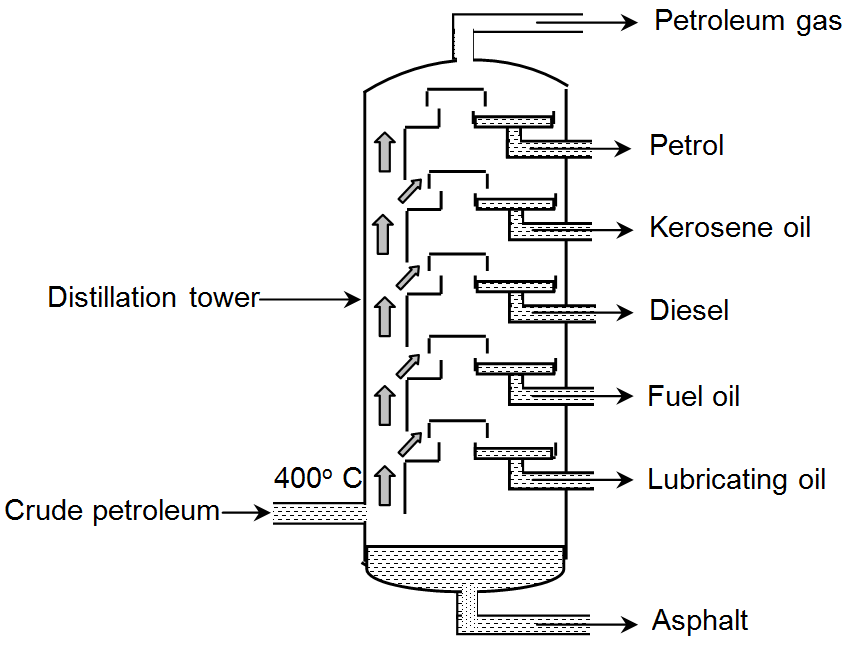Petroleum is a dark coloured viscous fossil fuel which was formed millions of years ago by anaerobic digestion of remains of sea animals that got buried in the earth. It is also called crude oil. Petroleum is present in the earth trapped between non-porous rocks in the form of large reservoirs. Petroleum is extracted from such reservoirs by drilling holes in the earth’s crust and sinking pipes in them.
The top petroleum producing countries in the world are: Saudi Arabia, U.S.A., Russia, Iran and Mexico. Unfortunately, Indian does not have rich resources of petroleum. In India petroleum is extracted in: Bombay High, Ankleshwar in Gujarat and Rudra Sagar and Lakwa in Assam.
Fractional Distillation of Petroleum
Petroleum is a mixture of large number of hydrocarbons. So, before using it, it becomes essential to separate it into its various fractions. The process which is used to separate various fractions of petroleum is known as fractional distillation. The fractional distillation of petroleum is done in a tall distillation tower.
To separate various fractions of petroleum, first of all petroleum is heated to a temperature of 4000C. At this temperature all the fractions of petroleum except asphalt begins to vaporize. Then these vapours are fed into the bottom of the distillation tower. In the distillation tower, the vapours of petroleum rises up, get cooled and condense into different liquids at different heights. The remaining gases which do not liquefy are taken out from the top of the distillation tower. Finally, the various fractions of petroleum that condensed at different heights of distillation tower are collected and stored. The fractions of petroleum obtained in the distillation tower from bottom to the top are: asphalt, lubricating oil, fuel oil, diesel oil, kerosene oil, petrol and petroleum gas.
All the fractions of petroleum except asphalt and lubricating oil are used as fuel because they can easily burn and produce a large amount of heat. The fuel oil is heavy grade oil which is used as fuel in ships. The diesel oil is used as fuel in heavy vehicles like tractors, trucks, buses, railway engines etc. kerosene oil is usually used in homes for cooking food. Petrol is used to power cars, scooters, motor cycles and piston engined aircrafts.

The gas collected from the top of the distillation tower is called petroleum gas. It is a mixture of many gases like butane, propane and ethane. However, the main constituent of petroleum gas is butane. The number of carbon atoms present in petroleum gas ranges between C1 to C4. Petroleum can be easily liquefied by applying pressure. In the liquid state it is called liquefied petroleum gas or LPG. Cooking gas cylinders used in homes contain liquefied petroleum gas. LPG is used in homes to cook food because it burns easily with a blue flame and produce a lot of heat. Also it does not produce smoke and other poisonous gases during combustion.
Precautions during leakage of LPG
Liquid petroleum gas is an odourless gas. So, to detect its leakage one more gas called ethyl mercaptan is added in it. In case of detection of leakage of LPG following precautions should be used:
1. Do not light the match stick.
2. Do not switch on or off electrical appliances.
3. Open all the windows and doors to allow the gas to escape.
4. Immediately close the valve of cylinder and knob of burner.
5. Inform the gas agency.
Test Your Understanding and Answer These Questions:
- What is petroleum or crude oil?
- How is petroleum formed?
- What is fractional distillation?
- Explain fractional distillation of petroleum.
- What is lpg?
- Which gas is mixed in lpg to detect its leakage?
- Which gas is mixed in lpg to detect its leakage?
